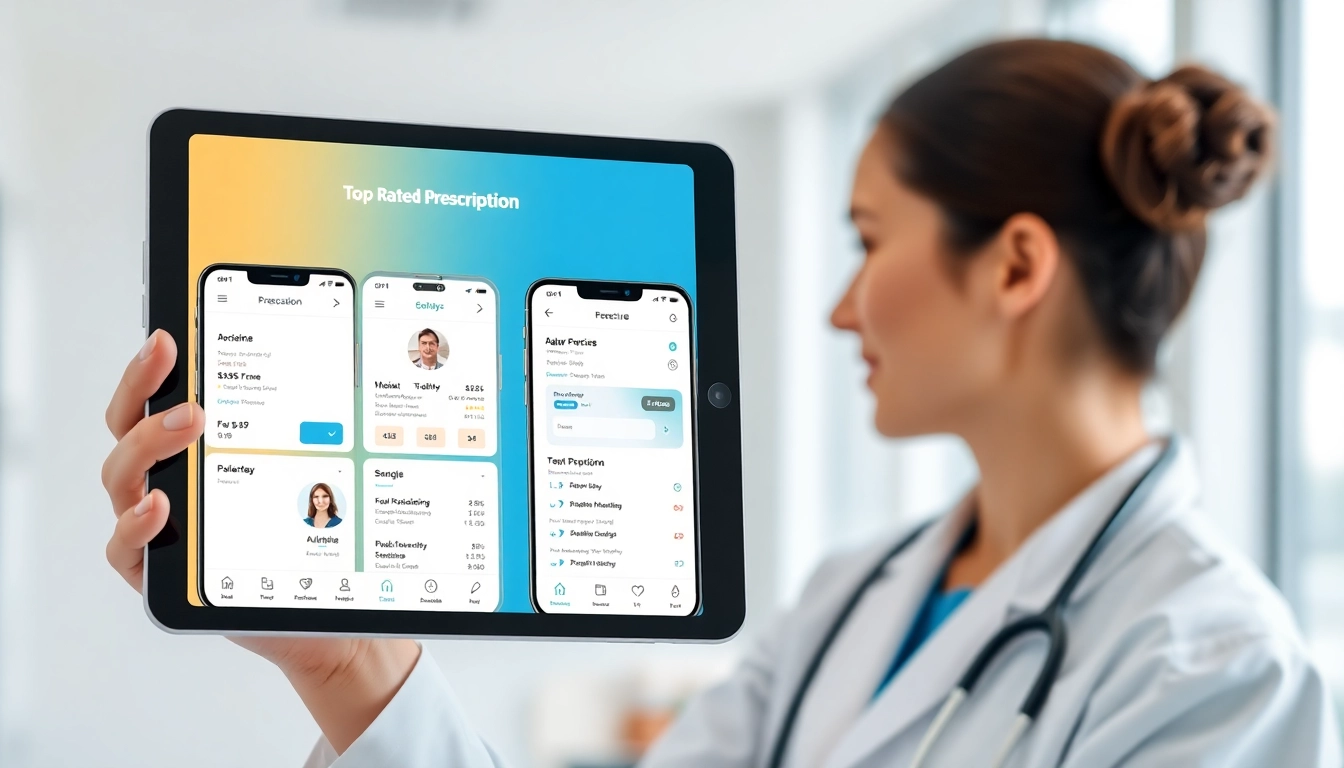Understanding Top Rated Prescription Applications
Definition and Purpose of Prescription Applications
In the rapidly evolving landscape of healthcare technology, top rated prescription applications have emerged as essential tools in managing medication, ensuring adherence, and enhancing patient outcomes. These applications serve multiple purposes, such as allowing users to manage their medication schedules, communicate with healthcare providers, and access medication information from their devices. They integrate various functionalities to streamline the prescription process, providing a user-friendly interface aimed at improving the overall healthcare experience.
Key Features of Top Rated Prescription Applications
Top rated prescription applications typically include several key features that enhance their usability and value for both patients and healthcare providers. Common functionalities include:
- Medication Management: Users can track their prescriptions, dosages, and refill dates, ensuring they stay on top of their medication regimens.
- Reminder Alerts: Various applications offer customizable reminders to take medications, schedule refills, and attend doctors’ appointments.
- Telehealth Integration: Many applications allow users to consult with healthcare providers virtually, facilitating communication and medication management from home.
- Drug Information Access: Instant access to reliable drug information, including potential side effects and interactions, fosters informed decision-making by patients and caregivers.
- Prescription Price Comparisons: Some applications enable users to compare medication prices across pharmacies, helping them to choose the most cost-effective options.
Benefits for Patients and Healthcare Providers
The advantages of utilizing top rated prescription applications extend to both patients and healthcare providers:
- Improved Adherence: With regular reminders and management tools, patients experience improved adherence to prescribed medications, which can lead to better health outcomes.
- Convenience and Accessibility: Patients can refill prescriptions, set appointments, and manage their health records all in one place, reducing friction in the healthcare experience.
- Enhanced Communication: Healthcare providers can communicate effectively with patients, facilitating the exchange of vital information and support.
- Data-Driven Insights: Applications often collect health metrics and medication history, enabling providers to make better-informed decisions based on available data.
- Cost Savings: Access to price comparisons helps patients find the most affordable options for their medications, minimizing out-of-pocket expenses.
Popular Categories of Top Rated Prescription Applications
Medication Management and Reminders
At the core of many top rated prescription applications are features dedicated to medication management and reminders. These applications seek to simplify the process of tracking medications, providing users with reminders to take their prescriptions at the right times. For example, applications like medication reminders can be tailored to individual schedules, ensuring that users receive timely notifications. Some applications even offer additional tools like logging side effects, which can contribute to ongoing communication with healthcare providers.
Telehealth and Virtual Consultations
One of the most significant shifts in healthcare has been the rise of telehealth services, which allow patients to connect with healthcare providers remotely. Top rated prescription applications increasingly include features that support telehealth consultations, enabling users to request prescriptions, receive assessments, and follow up on treatments without needing to visit a clinic. This capability not only provides convenience but also increases access to care for individuals in remote or underserved areas.
Prescription Price Comparison Tools
For patients managing chronic conditions or long-term medications, cost can often be a barrier to adherence. Top rated prescription applications that offer price comparison tools empower patients to compare medication prices between pharmacies. This feature can help users identify the most affordable option for their prescriptions, which is particularly important in a healthcare landscape where medication costs are rising. By enabling users to avoid unnecessary financial burdens, these applications promote better adherence and health outcomes.
Evaluating User Experience in Top Rated Prescription Applications
Importance of User-Centric Design
In any technology-driven field, user experience (UX) plays a crucial role in ensuring that applications are effective and widely adopted. Top rated prescription applications prioritize user-centric design, focusing on intuitive interfaces that facilitate easy navigation and access to key features. This approach involves understanding user needs through feedback, testing, and iterative design improvements, ultimately leading to higher satisfaction and usability rates.
Accessibility Features That Matter
Accessibility is a cornerstone of effective healthcare applications. Top rated prescription applications strive to incorporate features that accommodate users with varying abilities. This can include voice commands for functionality, adjustable text sizes, color contrast options, and compatibility with screen readers. By ensuring that all users can effectively utilize the application, developers create a more inclusive healthcare environment.
Feedback and Rating Systems to Enhance Trust
User feedback and rating systems hold significant importance in building trust around top rated prescription applications. Applications that actively seek and respond to user reviews demonstrate a commitment to improvement and accountability. Integrating rating systems allows potential new users to gauge the effectiveness and reliability of the application while enabling developers to identify areas that are successful as well as those needing enhancement.
Challenges in the Development of Top Rated Prescription Applications
Regulatory Compliance and Security Issues
The healthcare sector is heavily regulated, and top rated prescription applications must adhere to strict guidelines to ensure patient safety and privacy. Compliance with regulations such as HIPAA (Health Insurance Portability and Accountability Act) is essential to protect patient information. Developers must prioritize security measures, including data encryption and secure authentication processes, to maintain user trust and safeguard sensitive health information.
Integration with Existing Healthcare Systems
Integrating top rated prescription applications within existing healthcare systems presents another significant challenge. Healthcare facilities and providers often employ various electronic health record (EHR) systems, creating potential barriers for interoperability. Top rated applications must navigate these complexities to ensure seamless data exchange between platforms, which can enhance the overall healthcare experience for both patients and providers.
User Adoption and Education
Even the most well-designed applications can face challenges with user adoption. Lack of familiarity with technology, older demographics, or healthcare provider preference for traditional methods can hinder uptake. To combat this, effective educational strategies should accompany the application launch, highlighting ease of use and the tangible benefits of engaging with the technology. Providing accessible resources, such as tutorials and support, is essential to facilitate user engagement and promote adoption.
The Future of Top Rated Prescription Applications
Emerging Trends in Healthcare Technology
As technology continues to evolve, so will the landscape of healthcare applications. Key trends on the horizon include enhanced integration with artificial intelligence and machine learning technologies, which can provide personalized medication recommendations based on user data and insights. Future top rated prescription applications are also likely to embrace blockchain technology for secure and transparent data management.
AI and Machine Learning in Prescription Apps
The incorporation of AI and machine learning can revolutionize the functionalities of top rated prescription applications. These technologies can analyze user behavior and health data to generate tailored recommendations and reminders, ensuring that patients have the support they need to manage their health actively. Furthermore, AI can assist healthcare providers in making informed decisions regarding treatment pathways, promoting improved outcomes for patients.
Anticipating User Needs for Continuous Improvement
Ultimately, the future success of top rated prescription applications relies on a continuous commitment to user feedback and iterative development. Regular updates that address user needs and incorporate emerging trends will be vital in maintaining relevance and satisfaction. By remaining adaptable and responsive to patients and healthcare providers, developers can ensure that the applications continue to deliver valuable support in medication management and healthcare overall.



